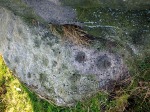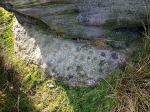NGR: SD 99905 40664. In the middle of a farmer’s field next to a drystone wall at Far Slippery Ford, Newsholme Dean, near Oak-worth, in west Yorkshire, there is a large glacial rock which is locally called William Walker’s Stone. The rock takes its name from a local farmer who had farmed the fields around here. After his passing in 2002 an inscription to his memory was carved onto the bottom of the rockface; there are a few more recently carved inscriptions on the rock. Also of interest: there are several faint cup-marks on the top surface of the rock and a partial ring with cup-markings inside it, but these are now very faint and difficult to make out when the light is not good, although when its raining these carvings are more visible to the eye. There are other cup-marked rocks and boulders 730 metres to the east at Greystones Farm. These erratic rocks and boulders, known as earth-fast, were deposited by the retreating glacier moving southwards 13,000-15,000 years ago; then coming forward in the late Neolithic and early Bronze Ages our distant ancestors carved these cup marks onto the smooth rock faces. From the A6068 at Cowling take Oakworth Old Lane (past the graveyard), Piper Lane, Buckstone Lane, Dick Lane, Long Gate, then Far Slippery Ford Lane to Walker’s Farm (on your left); here take the gated trackway (opposite) for a while until you see the boulder up against the wall in the field over to the SW.
William Walker’s Stone is around 6 feet high and lies on its own here against a drystone wall. There are, though, other similar earth-fast rocks and boulders over to the east at Greystones and, further to the north on Sutton Moor, there are the Buck Stone, Hitching Stone, Kid Stone and Quicken Stone. But William Walker’s Stone is the only stone of those to have definite prehistoric cup-and-ring markings, which are also known as petroglyphs. There are said to be perhaps up to twenty cup-markings (circular depressions) on the top of the stone and a very worn ring can just be made out next to a small and shallow rock basin. The partial ring has several cup-markings around its edge and within it, which almost make it look like a face. There are maybe a few other cups with rings in a line on the upper side of the rock, though these might be more recent. There are also some curious grooves on the top of the stone but these might be naturally-formed features caused by weather-related erosion. The Northern Antiquarian discovered the rock carvings on William Walker’s Stone back in 2006, and, they also noted what might be a boundary mark with the letters “I W”, although the stone does not appear to have ever marked any such boundary!
Near the bottom of the eastern face of the stone can be found an inscription or epitaph to the memory of a local farmer, William Walker. The inscription is difficult to read now due to moss growing in the lettering, but it looks to say: William Walker Farmed here 1963 to 2002. The Walker family still farm here and their farmhouse is on the opposite side of the lane from the gated trackway. And another inscription, possibly to another farmer, reads: F. Allen 1958-63.
On your way back to the track/footpath you will notice a nice little well in the grassy field. I don’t know anything about how old it is but obviously the spring is very ancient. Water issues out of a plastic pipe and into a rectangular stone basin, which is flat to the ground. There is a channel allowing the water to overflow out of the basin and into a stony area at the front and then downwards into the field. The water looks very clear coming out of the pipe.
Sources / References & Related Websites:-
William Walker Stone, Keighley Moor, West Yorkshire | The Northern Antiquarian (wordpress.com)
William Walker Stone (Keighley Moor) [IAG0b] Rock Art : The Megalithic Portal and Megalith Map:
Greystones Farm Cup-Marked Rocks, Near Newsholme Dean, West Yorkshire | The Journal Of Antiquities
Slippery Ford :: Survey of English Place-Names (nottingham.ac.uk)
Copyright © Ray Spencer, The Journal of Antiquities, 2021.

































